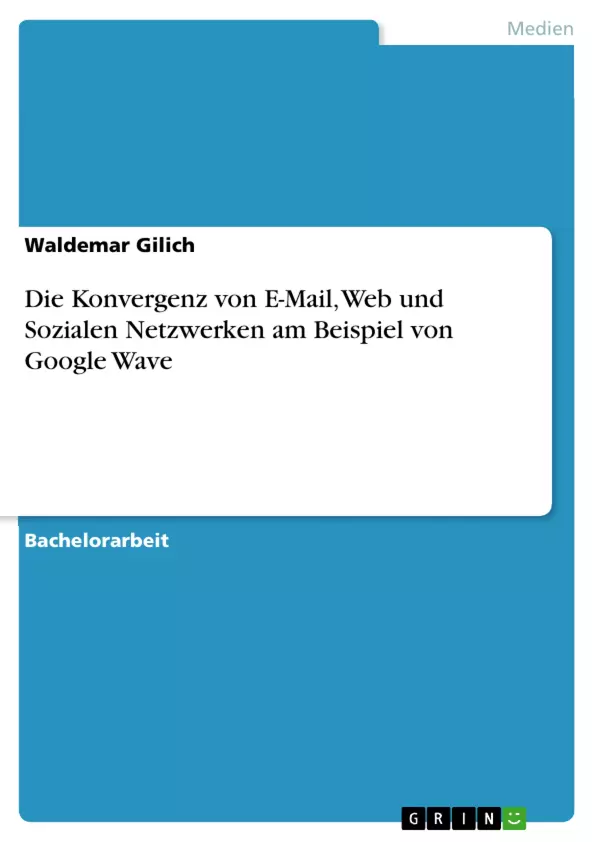Die Kommunikation der Zukunft, unter diesem Aspekt hat Google Inc. ihr neues online System »Wave« entwickelt. Mit diesem innovativen Produkt versucht das Unternehmen die Kommunikation im Web zu vereinfachen und zu revolutionieren. In Google Wave werden deswegen zahlreiche bekannte Technologien, wie E-Mail, Instant Messaging und Wikis kombiniert, mit dem Ziel diese Dienste und Anwendungen im Laufe der Zeit ersetzen zu können. In dieser Bachelorarbeit wird die Konvergenz dieser Technologien, Anwendungen und Dienste in Google Wave behandelt.
Inhaltsverzeichnis
- Vorwort
- 1 Einleitung
- 2 Zielsetzung der Arbeit
- 3 Aktueller Stand von Kommunikationstechnologien
- 3.1 Web 2.0 – Herleitung und Definition
- 3.2 Social Software Anwendungen
- 3.3 Microblogging-Dienste
- 4 Google Wave
- 4.1 Die Entstehung von Google Wave
- 4.2 Was ist Google Wave? – Die Konvergenz verschiedener Technologien
- 4.3 Nutzungsanforderungen und Aufbau
- 4.4 Google Wave Technologie, API & Protokoll
- 4.5 Google Wave Client Interface
- 4.6 Umgang mit dem Google Wave Client
- 4.7 Account Management und Suchfunktionen
- 4.8 Einsatzmöglichkeiten von Google Wave
- 4.9 Die Ziele, Ökonomie und Konkurrenz von Google Wave
- 5 Fazit & Ausblick
Zielsetzung und Themenschwerpunkte
Die Bachelorarbeit beschäftigt sich mit der neuen Online-Plattform Google Wave. Sie soll den aktuellen Stand der Kommunikationsentwicklung im Web aufzeigen und dabei Wissen über verschiedene Webtechnologien vermitteln. Besonderes Augenmerk liegt auf der Kombination verschiedener Technologien in Google Wave sowie der Funktionsweise des Client Interfaces.
- Konvergenz von Kommunikationstechnologien in Google Wave
- Aufbau und Funktionsweise von Google Wave
- Umgang mit dem Client Interface von Google Wave
- Einsatzmöglichkeiten von Google Wave im Unternehmens- und Privatbereich
- Ziele von Google mit der neuen Technologie
Zusammenfassung der Kapitel
- Kapitel 1: Einleitung Das Kapitel führt in das Thema der Bachelorarbeit ein und stellt Google Wave als ein Echtzeit-Kommunikationssystem vor, das die Kommunikation und Kollaboration im Web revolutionieren soll.
- Kapitel 2: Zielsetzung der Arbeit Dieses Kapitel beschreibt die Ziele der Arbeit, die darin bestehen, einen detaillierten Einblick in den Aufbau, die Funktionsweise und die Verwendung von Google Wave zu bieten.
- Kapitel 3: Aktueller Stand von Kommunikationstechnologien Das Kapitel behandelt den aktuellen Stand von Webtechnologien, insbesondere Web 2.0, Social Software Anwendungen und Microblogging-Dienste. Es erläutert die Herleitung und Definition des Begriffs Web 2.0 und beschreibt verschiedene Social Software-Anwendungen, wie Blogs, Podcasts, Wikis, Social Tagging, Social Bookmarking, Social Networks, Online-Dokumente, E-Mail, Online Communities, Instant Messaging und Mashups. Den Abschluss bildet eine detaillierte Beschreibung von Microblogging-Diensten wie Twitter.
- Kapitel 4: Google Wave Dieses Kapitel befasst sich mit der neuen Plattform von Google Inc., Namens Google Wave, und analysiert deren Aufbau und Funktionsweise. Es erläutert die in Google Wave kombinierten Technologien, wie E-Mail, Instant Messaging, Online Communities, Soziale Netzwerke, Wikis, Online-Dokumente, Social Tagging, Photo Sharing und Mashups. Das Kapitel behandelt auch das Interface des Google Wave Clients, die Google Wave Technologie, die API & Protokoll und das Google Wave Federation Protokoll sowie den Umgang mit dem Google Wave Client, die Account Management und Suchfunktionen, die Einsatzmöglichkeiten von Google Wave und die Ziele, Ökonomie und Konkurrenz von Google Wave.
Schlüsselwörter
Die wichtigsten Schlüsselwörter der Arbeit sind Kommunikation, Web, Wave, Google, Kollaboration, Social Software, soziale Netzwerke, Microblogging, Konvergenz, E-Mail, Raindrop, API, Protokoll, HTML5, AJAX, Operational Transformation, Gadgets, Robots und Open Source.
- Quote paper
- B. Eng. Waldemar Gilich (Author), 2010, Die Konvergenz von E-Mail, Web und Sozialen Netzwerken am Beispiel von Google Wave, Munich, GRIN Verlag, https://www.grin.com/document/155522



